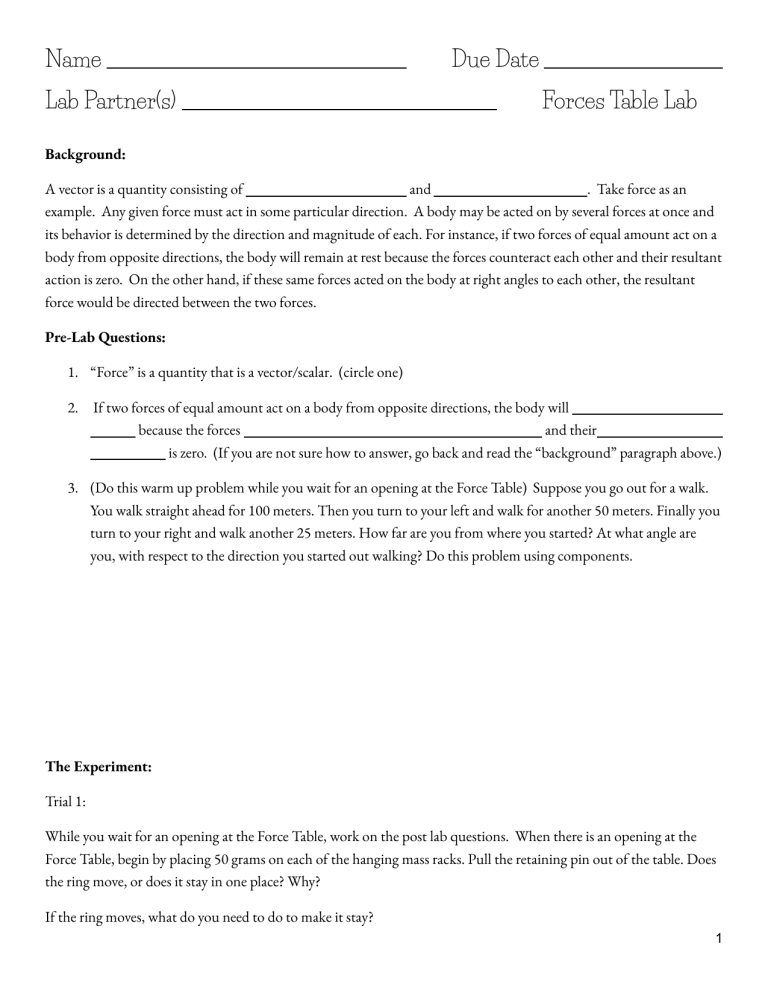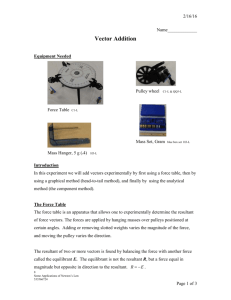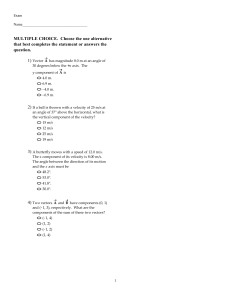
Name Due Date Lab Partner(s) Forces Table Lab Background: A vector is a quantity consisting of and . Take force as an example. Any given force must act in some particular direction. A body may be acted on by several forces at once and its behavior is determined by the direction and magnitude of each. For instance, if two forces of equal amount act on a body from opposite directions, the body will remain at rest because the forces counteract each other and their resultant action is zero. On the other hand, if these same forces acted on the body at right angles to each other, the resultant force would be directed between the two forces. Pre-Lab Questions: 1. “Force” is a quantity that is a vector/scalar. (circle one) 2. If two forces of equal amount act on a body from opposite directions, the body will because the forces and their is zero. (If you are not sure how to answer, go back and read the “background” paragraph above.) 3. (Do this warm up problem while you wait for an opening at the Force Table) Suppose you go out for a walk. You walk straight ahead for 100 meters. Then you turn to your left and walk for another 50 meters. Finally you turn to your right and walk another 25 meters. How far are you from where you started? At what angle are you, with respect to the direction you started out walking? Do this problem using components. The Experiment: Trial 1: While you wait for an opening at the Force Table, work on the post lab questions. When there is an opening at the Force Table, begin by placing 50 grams on each of the hanging mass racks. Pull the retaining pin out of the table. Does the ring move, or does it stay in one place? Why? If the ring moves, what do you need to do to make it stay? 1 If the ring moves, then make your adjustments such that it stays xed. What is the magnitude of the force on each of the masses? The same two forces are acting on the central ring. What are the directions of the forces acting on the rings (i.e., what are the angles)? Record each of these values in the data table below. Then go back to your seat and let the next lab group have their turn. Trial 1 Results Force F1 F2 Magnitude (N) Direction (θ) On the graph to the right, sketch and label the two force vectors using the head to tail method. Next, draw the resultant and label it, R. Lastly, draw the equilibrant in a di erent color and label it, E. Notice how adding the vectors graphically demonstrates that the net force on the central ring is zero. Verify this algebraically by showing that the sum of the components of the two vectors is also zero. Now, notice that you can slide the ring back and forth along the x axis, placing it at any distance, and the ring will stay in place. This means that every point along the x axis is an equilibrium point. Explain why this is the case. 2 Trial 2: Now, let’s add another pulley. Using the third string attached to the ring, add a third mass rack. Now, place two pulleys at angles θ = 0◦ , and θ = 120◦ . Replace the retaining pin through the ring in the center of the table. Hang two mass racks over the pulleys, and place 100 grams on each of them. Place a third pulley at some angle at which you expect the system to balance. (Roughly what angle do you expect this to be?) Now, place 100 grams on the nal mass rack, and thread its string over the third pulley. If the system does not balance for the predicted angle that you chose, slide the pulley around until the ring balances in the center. When it does, remove the retaining pin. For the angle that you have found, enter your values in the following table, and go back to your seats to free up the Force Table. Trial 2 Results Force F1 F2 F3 Magnitude (N) Direction (θ) On the graph to the right, sketch and label the two force vectors using the head to tail method. Next, draw the resultant and label it, R. Lastly, draw the equilibrant in a di erent color and label it, E. Notice how adding the vectors graphically demonstrates that the net force on the central ring is zero. Verify this algebraically by showing that the sum of the components of the two vectors is also zero. 3 Trial 3: Finally, for 100 grams on a rack over a pulley at θ = 45◦ and 200 grams on a rack over a pulley at θ = 150◦ . How much mass, and at what angle, do you need to balance the forces? Do your calculations and record your prediction in the data table below. Trial 2 Results Force Magnitude (N) Direction (θ) F1 F2 F3 (theoretical) F4 (experimental) Now, perform the experiment and measure the angle and mass at which the system balances. Record the experimental value in the data table. Do your results agree? If not, what is your experimental error? What could be throwing o your results (i.e., what are some possible sources of error)? 4 Post-Lab Questions: 1. A eld mouse trying to escape a hawk runs east for 5.0 m, darts southeast for 3.0 m, then drops 1.0 m straight down a hole into its burrow. What is the magnitude of the net displacement of the mouse? 2. A ock of ducks is trying to migrate south for the winter, but they keep being blown o course by a wind blowing from the west at 6.0 m/s. A wise elder duck nally realizes that the solution is to y at an angle relative to the wind. If the ducks can y at 8.0 m/s relative to the air, what direction should they head in order to move directly south? 3. The gure to the right shows three ropes tied together in a knot. One of your friends pulls on a rope with 3.0 units of force and another pulls on a second rope with 5.0 units of force. How hard, and in what direction, must you pull on the third rope to keep the knot from moving? 5




